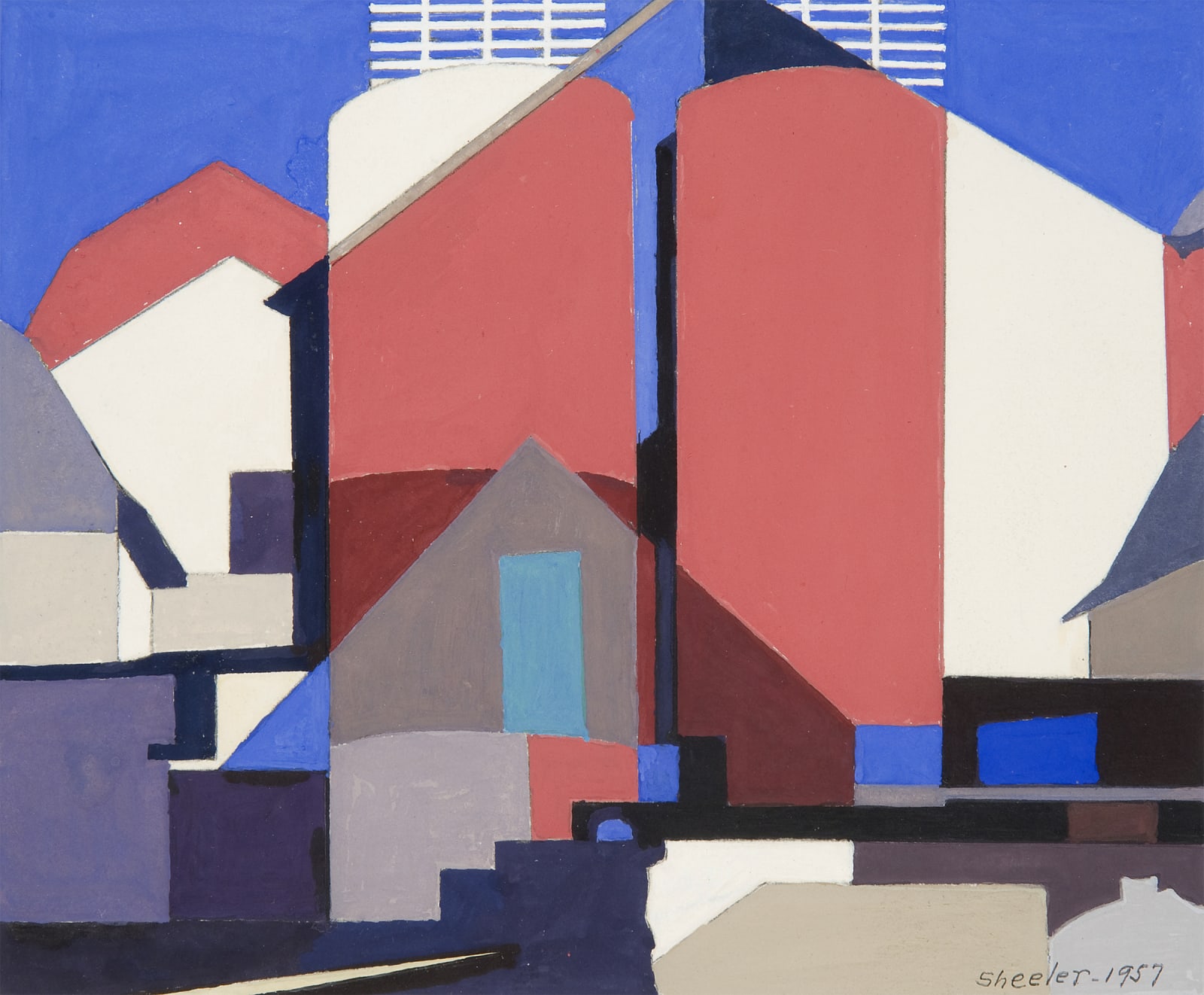Charles Sheeler American, 1883-1965
Red Against the White, 1957
Signed and dated at lower right: Sheeler - 1957
Tempera on board
5 x 6 inches
12.7 x 15.2 cm
12.7 x 15.2 cm
Since at least the early 1940s, Sheeler had used multiple exposures to make photographic prints as compositions for his paintings. In Red Against The White, he used this process to...
Since at least the early 1940s, Sheeler had used multiple exposures to make photographic prints as compositions for his paintings. In Red Against The White, he used this process to express a new treatment of Precisionism. Sheeler began transferring photographs and drawings onto Plexi and glass as a means to rapidly simply forms into blocks of color—color that could be easily scrubbed off of the plastic support and replaced as he tinkered with the composition. He initially considered these transparent works as detritus of the process, but, by the mid-1950s, began to see the aesthetic value in these preparatory works and brought them to a finished state for exhibition. The Plexiglas tempera that served as a study for Red Against The White, thankfully, was preserved, and is now in the collection of the Museum of Fine Arts, Boston. Photography and Plexiglas offered Sheeler a mechanical Cubism, using multiple negatives—or, in this case, a simple flipped negative—to create the simultaneity of multiple views that Picasso and Braque gestured at in the 1910s—with the critical amendment that Sheeler’s method is definitively mechanical. In this way, Sheeler’s was an objective response to the subjectivity of Cubism and its many progeny. This objectivity also allowed Sheeler to be absent from his own work, as if the cubist program could be completed by machine alone. Sheeler completes the paean to modernity in Precisionism as both the subject and the means of his picture are industrialized. This supports a view of Sheeler’s oeuvre that finds his work cold and emotionally distant. His most successful works all have a façade of cool formalism behind which, one sense, a deeply personal narrative is concealed.
Red Against The White masterfully suggests such a personal narrative. The swelling industrial forms evoke the same totemic magnificence as Charles Demuth’s masterpiece, My Egypt (1927, Whitney Museum of American Art, New York): tall, triangular, and inscrutable, the forms of Red Against The White are pyramids for the mid-twentieth-century American painter and photographer.
Red Against The White masterfully suggests such a personal narrative. The swelling industrial forms evoke the same totemic magnificence as Charles Demuth’s masterpiece, My Egypt (1927, Whitney Museum of American Art, New York): tall, triangular, and inscrutable, the forms of Red Against The White are pyramids for the mid-twentieth-century American painter and photographer.
Provenance
The artist; to[The Downtown Gallery, New York]; to
Edith G. Halpert, New York;
By descent to private collection, Washington, D.C.;
[Alexandre Fine Art, Inc., New York]; to
Private collection, New York, until the present
Exhibitions
The Downtown Gallery, New York, 32nd Annual Exhibition, December 31, 1957-January 23, 1958, no. 11 // The Corcoran Gallery of Art, Washington, D.C., A Loan Exhibition from The Edith Gregor Halpert Collection, January 16-February 28, 1960, no. 72 // Denver Art Museum, Denver, Colorado; Burchfield Penney Art Center, Buffalo, New York, What It Meant To Be Modern, 1910-1965: American Works on Paper from the Karen and Kevin Kennedy Collection, August 21, 2016-June 23, 2017Literature
Hermann Warner Williams, Jr., A Loan Exhibition from The Edith Gregor Halpert Collection, Washington, D.C., 1960, no. 72, n.p. // Nannette V. Maciejunes, What It Meant To Be Modern, 1910-1965: American Works on Paper from the Karen and Kevin Kennedy Collection, Denver, Colorado: Denver Art Museum, 2016, illus. in color p. 24Josh Nefsky

